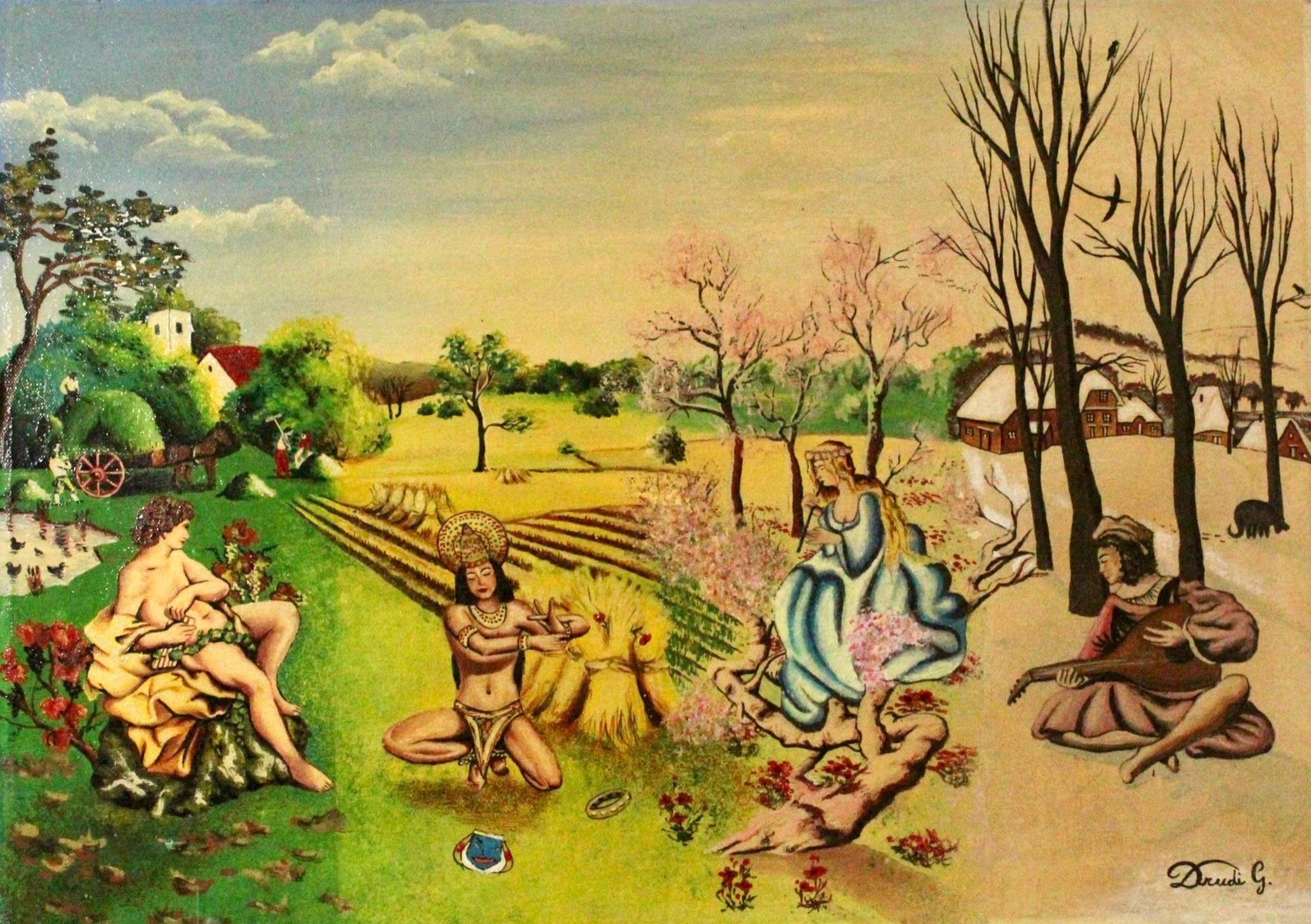THE 4 SEASONS
1978, 50x70cm, Tempera on canvas with glossy spray fixative

Each character represents a different season, the seasons follow one another on the same landscape. The vivid colors and mysterious characters convey calm and reflection to the observer.
The work “The 4 Seasons,” created in 1978 with tempera on canvas and glossy spray fixative, is a poetic and symbolic representation of the cycle of nature, in which the seasons follow harmoniously within the same landscape. With a skillful use of color and a balanced composition, the artist creates an effect of visual continuity, showing the changing of time through the metamorphosis of the landscape and the presence of allegorical figures.
A landscape that transforms:
The work is divided into four sections, each representing a season through chromatic variations, natural elements, and symbolic human figures:
Spring is depicted with delicate and soft colors, flowering trees, and an ethereal female character, dressed in blue, blowing petals in the wind, symbolizing rebirth and the lightness of the season.
Summer is dominated by warm and golden tones. A man with a ritual headdress kneels next to sheaves of wheat, evoking the harvest and fertility of the earth. The intense light and richness of details enhance the abundance typical of this period.
Autumn is represented with reddish tones and darker greens. A seminude young man, wrapped in a golden drape, sits next to a bush of vines loaded with grapes, embodying the time of the grape harvest and wine, a symbol of transformation and maturity.
Winter is characterized by cold tones, bare trees, and a snowy landscape. A man with a lute, wrapped in a cloak, sits next to a forest of black trees and houses with white roofs, evoking the quiet, recollection, and sense of melancholy typical of the cold season.
An invitation to reflection:
The work is not limited to representing the seasons in a static way but invites the observer to contemplate time as a continuous cycle, in which each phase of life has its beauty and meaning. The combination of vivid and dark colors, the fluid transition between seasons, and the presence of mysterious characters give the scene a poetic, almost fairy-tale aura.
Conclusion:
“The 4 Seasons” is a painting that expresses harmony and reflection, suggesting how the passing of time is part of a natural balance. Thanks to a refined technique and the use of symbolic details, the work manages to convey a sense of calm and connection with the cyclicity of nature, inviting the viewer to immerse themselves in the beauty of change.

Each character represents a different season, the seasons follow one another on the same landscape. The vivid colors and mysterious characters convey calm and reflection to the observer.
The work “The 4 Seasons,” created in 1978 with tempera on canvas and glossy spray fixative, is a poetic and symbolic representation of the cycle of nature, in which the seasons follow harmoniously within the same landscape. With a skillful use of color and a balanced composition, the artist creates an effect of visual continuity, showing the changing of time through the metamorphosis of the landscape and the presence of allegorical figures.
A landscape that transforms:
The work is divided into four sections, each representing a season through chromatic variations, natural elements, and symbolic human figures:
Spring is depicted with delicate and soft colors, flowering trees, and an ethereal female character, dressed in blue, blowing petals in the wind, symbolizing rebirth and the lightness of the season.
Summer is dominated by warm and golden tones. A man with a ritual headdress kneels next to sheaves of wheat, evoking the harvest and fertility of the earth. The intense light and richness of details enhance the abundance typical of this period.
Autumn is represented with reddish tones and darker greens. A seminude young man, wrapped in a golden drape, sits next to a bush of vines loaded with grapes, embodying the time of the grape harvest and wine, a symbol of transformation and maturity.
Winter is characterized by cold tones, bare trees, and a snowy landscape. A man with a lute, wrapped in a cloak, sits next to a forest of black trees and houses with white roofs, evoking the quiet, recollection, and sense of melancholy typical of the cold season.
An invitation to reflection:
The work is not limited to representing the seasons in a static way but invites the observer to contemplate time as a continuous cycle, in which each phase of life has its beauty and meaning. The combination of vivid and dark colors, the fluid transition between seasons, and the presence of mysterious characters give the scene a poetic, almost fairy-tale aura.
Conclusion:
“The 4 Seasons” is a painting that expresses harmony and reflection, suggesting how the passing of time is part of a natural balance. Thanks to a refined technique and the use of symbolic details, the work manages to convey a sense of calm and connection with the cyclicity of nature, inviting the viewer to immerse themselves in the beauty of change.